For a standard run-of-the mill piezo buzzer (as in the image below), what order of magnitude would the deformation be (compared to 0V) that occurs when driving it within its normal operating conditions? Micrometers?
Asked
Active
Viewed 227 times
2
-
1Link to a proper data sheet. Then you can calculate it from sound pressure levels, surface area and operating frequency (if it isn't explicitly stated). – Andy aka Sep 22 '21 at 12:49
-
For example: https://www.arduino.cc/documents/datasheets/PIEZO-PKM22EPPH4001-BO.pdf SPL is ~90dB typical. – Larsupial Sep 22 '21 at 13:01
-
Some important words you might have missed in my earlier comment: **Then you can calculate** - also there are probably about 100 different types in that link. Focus on one and YOU do the math. If you need formulas, the internet should be good for that. – Andy aka Sep 22 '21 at 13:06
-
1Thanks Andy, I didn't miss those words. Was just thinking that this deformation would not be linear, so a simple model like a plunger (is that the right word?) moving up and down wouldn't cut it. Manufacturers do not seem to state it explicitly, since why would they? – Larsupial Sep 22 '21 at 13:09
-
1If you have any machinist friends, could mount a dial indicator (micrometer) and likely get a physical reading of the actual displacement. – rdtsc Sep 22 '21 at 13:39
-
Good suggestion rdtsc, thanks. Would such a micrometer pose an opposing force to the piezo disc? I was thinking of polishing the side of the piezo, then using a laserpointer and measuring the deflection of the reflection a few meters away, then fitting a curve to it. – Larsupial Sep 22 '21 at 13:50
-
These audio transducers are *flexure-mode* which means that disk's center moves the most, edges less. I'd suggest a **Michelson interferometer** with a laser-pointer light source, with a polished center-spot of the piezo as one of its 2-mirrors. Easily gives sub-micron resolution by counting fringes by eye. – glen_geek Oct 31 '21 at 00:14
1 Answers
3
Figure 3 in this paper implies on the order of 0.6 nm / V, so 3 nm with a 5 Vpp drive.
Davide Andrea
- 16,164
- 4
- 33
- 62
-
Interesting, thanks! But these are purpose-built piezo actuators. I'm specifically looking for an answer if someone tried to determine this for these simple buzzers. Just curious. – Larsupial Sep 22 '21 at 13:06
-
-
The X axis is the relative intensity. It says that by driving the piezo really hard, the deformation is not linear. Since Larsupial is asking about a standard audio piezo, the drive is small. Hence, the values lying on the left axis apply. And all the curves converge to about 600 pm/V. – Davide Andrea Sep 22 '21 at 13:28
-
1@Larsupial To your curiosity, see (in french ... how to measure ...) https://www.j3ea.org/articles/j3ea/pdf/2008/02/j3ea08012.pdf – Antonio51 Sep 22 '21 at 14:31
-
1Thanks Antonio51. Reported is ~400 pm/V, for 280 layers of piezo material (if interpreting the French right), close to Davide Andrea's value. Still wondering about these ubiquitous low-cost piezos buzzers. – Larsupial Sep 22 '21 at 14:41
-
2If I understood correctly, these buzzers are mounted on a (circular) brass plate and form a "beam" which deforms when a voltage is applied between the "terminals". Here also what I found https://i.stack.imgur.com/poNFH.png – Antonio51 Sep 22 '21 at 14:51
